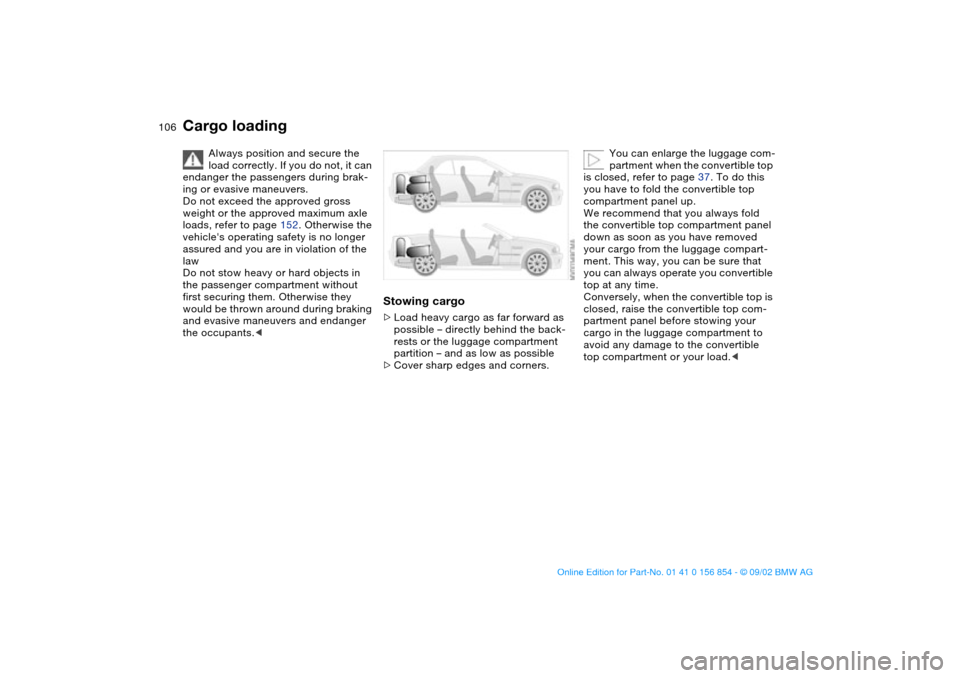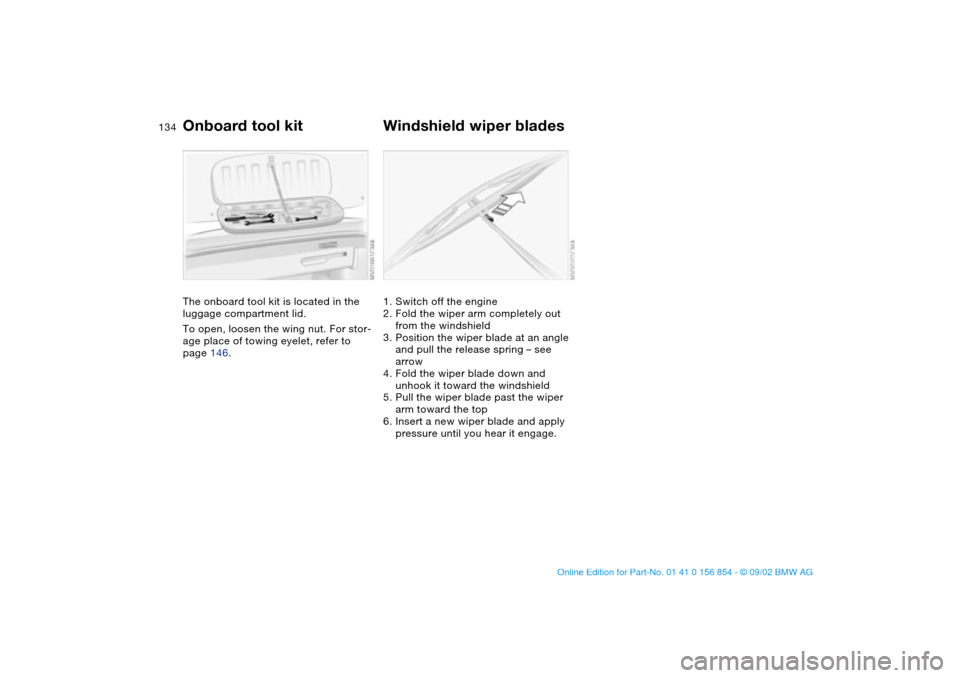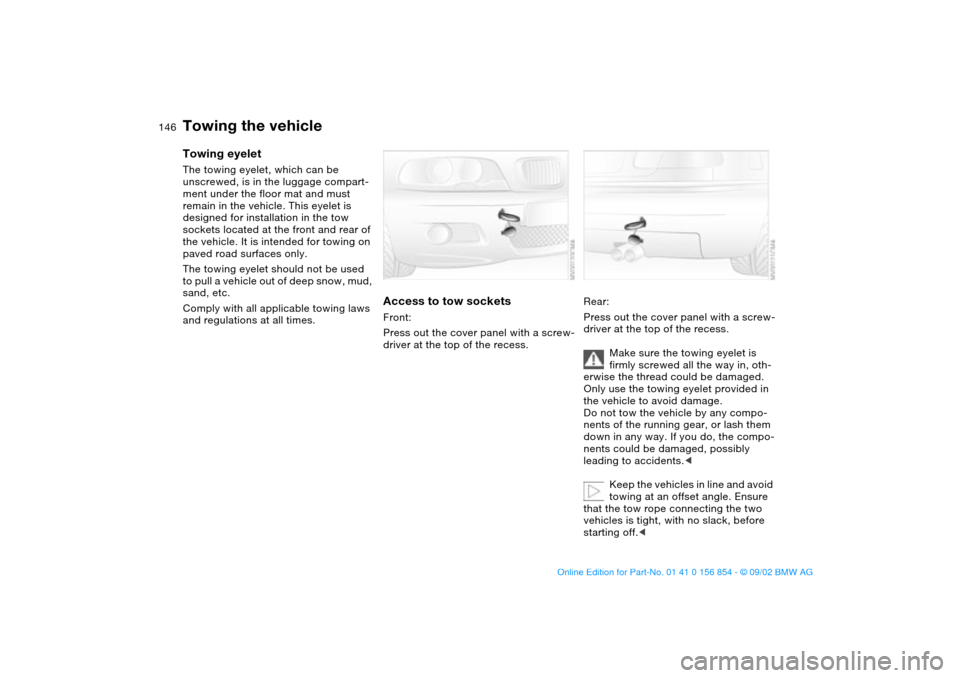2003 BMW M3 CONVERTIBLE towing
[x] Cancel search: towingPage 10 of 166

Contents
Owner service procedures
Replacement procedures:
Onboard tool kit134
Windshield wiper blades134
Lamps and bulbs135
Repairing a flat tire139
Battery143
Fuses144
Giving and receiving
assistance:
Jump-starting145
Towing the vehicle146
Technical data
Engine data150
Dimensions151
Weights152
Capacities153
Index
Everything from A to Z156
handbook.book Page 10 Tuesday, July 30, 2002 9:28 AM
Page 106 of 166

106
Cargo loading
Always position and secure the
load correctly. If you do not, it can
endanger the passengers during brak-
ing or evasive maneuvers.
Do not exceed the approved gross
weight or the approved maximum axle
loads, refer to page 152. Otherwise the
vehicle's operating safety is no longer
assured and you are in violation of the
law
Do not stow heavy or hard objects in
the passenger compartment without
first securing them. Otherwise they
would be thrown around during braking
and evasive maneuvers and endanger
the occupants.<
Stowing cargo>Load heavy cargo as far forward as
possible – directly behind the back-
rests or the luggage compartment
partition – and as low as possible
>Cover sharp edges and corners.
You can enlarge the luggage com-
partment when the convertible top
is closed, refer to page 37. To do this
you have to fold the convertible top
compartment panel up.
We recommend that you always fold
the convertible top compartment panel
down as soon as you have removed
your cargo from the luggage compart-
ment. This way, you can be sure that
you can always operate you convertible
top at any time.
Conversely, when the convertible top is
closed, raise the convertible top com-
partment panel before stowing your
cargo in the luggage compartment to
avoid any damage to the convertible
top compartment or your load.<
handbook.book Page 106 Tuesday, July 30, 2002 9:28 AM
Page 134 of 166

134Replacement procedures
Onboard tool kitThe onboard tool kit is located in the
luggage compartment lid.
To open, loosen the wing nut. For stor-
age place of towing eyelet, refer to
page 146.
Windshield wiper blades1. Switch off the engine
2. Fold the wiper arm completely out
from the windshield
3. Position the wiper blade at an angle
and pull the release spring – see
arrow
4. Fold the wiper blade down and
unhook it toward the windshield
5. Pull the wiper blade past the wiper
arm toward the top
6. Insert a new wiper blade and apply
pressure until you hear it engage.
handbook.book Page 134 Tuesday, July 30, 2002 9:28 AM
Page 146 of 166

146
Towing the vehicleTowing eyeletThe towing eyelet, which can be
unscrewed, is in the luggage compart-
ment under the floor mat and must
remain in the vehicle. This eyelet is
designed for installation in the tow
sockets located at the front and rear of
the vehicle. It is intended for towing on
paved road surfaces only.
The towing eyelet should not be used
to pull a vehicle out of deep snow, mud,
sand, etc.
Comply with all applicable towing laws
and regulations at all times.
Access to tow socketsFront:
Press out the cover panel with a screw-
driver at the top of the recess.
Rear:
Press out the cover panel with a screw-
driver at the top of the recess.
Make sure the towing eyelet is
firmly screwed all the way in, oth-
erwise the thread could be damaged.
Only use the towing eyelet provided in
the vehicle to avoid damage.
Do not tow the vehicle by any compo-
nents of the running gear, or lash them
down in any way. If you do, the compo-
nents could be damaged, possibly
leading to accidents.<
Keep the vehicles in line and avoid
towing at an offset angle. Ensure
that the tow rope connecting the two
vehicles is tight, with no slack, before
starting off.<
handbook.book Page 146 Tuesday, July 30, 2002 9:28 AM
Page 147 of 166

147
Use only a nylon towing strap to tow
the vehicle, since the inherent resil-
ience of this material helps protect both
vehicles from sudden jerking move-
ments.
The towed vehicle should always
be the lighter of the two vehicles.
If this is not the case, it will not be pos-
sible to control vehicle handling.
Never attempt to use your vehicle to
push another vehicle, since damage to
the energy-absorbing bumpers could
result.Towing a vehicle1. Gearshift lever in Neutral
2. Towing speed:
Max. 45 mph / 70 km/h
3. Towing distance:
Max. 95 miles/150 km
4. Leave the ignition key at position 1 to
ensure that the brake lamps, turn sig-
nal indicators, horn and windshield
wipers remain operative, and to pre-
vent the steering lock detent from
engaging
5. Switch on the hazard-warning sys-
tem – observe applicable legal regu-
lations.
Find some means of identifying the
vehicle in tow, for instance, place a sign
or warning triangle in the rear window.
Make sure that the ignition key
remains in position 1 even when
the electrical system has failed to pre-
vent the steering lock from engaging.
The steering and brakes are without
power-assist when the engine is off.
This means that increased effort is
required for steering and braking.<
Vehicle with sequential M gearbox
SMG II:
To push or tow, engage selector lever
in position 0.
Never work on the vehicle with a
driving position engaged.<
Towing with a commercial tow
truck>Do not tow with sling-type equipment
>Use wheel lift or flatbed equipment
>Please comply with applicable state
towing laws.
Never allow passengers to ride in
a towed vehicle for any reason.
Never attach tie-down hooks, chains,
straps, or tow hooks to tie rods, control
arms, or any other part of the vehicle
suspension, as severe damage to these
components will occur, possibly lead-
ing to accidents.<
Towing the vehicle
OverviewControlsMaintenanceRepairsDataIndex
handbook.book Page 147 Tuesday, July 30, 2002 9:28 AM
Page 158 of 166

Everything from A to ZEngine oil pressure
warning lamp 18
Engine speed 150
Entering the rear 51
Exterior mirrors 55
Eyelet, towing 146
F
False alarm, avoiding 39
Fault displays 82
First-aid kit 23
Flat tire 115
repairing 139
Flat Tire Monitor 88
indicator lamp 18, 19
Fog lamps 94
Fold down convertible top
compartment panel 37
Follow me home lamps 92
Footbrake 112
Footbrake, refer to Driving
notes 111
Footwell lamps 94
Front airbags 57
Front fog lamps 94
indicator lamp 20
Front seat adjustment 49
Frost protection,
radiator 126
Fuel 25
Fuel consumption 85
display 81Fuel filler door 24
release following an elec-
trical malfunction 24
Fuel gauge 81
Fuel specifications 25
Fuel tank capacity 153
Fuel tank display 81
Fuel tank gauge 81
Fuel-injection system 150
Fully automatic convertible
top 41
operation 41
Fuses 144
replacing 144
G
Gasoline 25
Gasoline gauge 81
Gearbox, sequential 71
Gearshift lever 70
Glove compartment 101
Grills 96
Gross vehicle weight 152
H
Hands-free system 102
Hardtop 113
Hazard warning flashers 14
Hazard warning triangle 23
Head restraints 50
Headlamp 92Headlamp cleaning system
122, 124, 153
Headlamp control 92
Headlamp flasher 76, 93
Heated mirror 55
Heated seats 54
Heavy loads 106
High beams 76, 93
indicator lamps 21
Holder for beverages 102
Hood release 120
Horn 14
Hydroplaning 111, 115
I
Ice warning 84
Ignition key 30
positions 66
Ignition lock 66
Imprint 4
Indicator lamps 18
Individual settings, Vehicle
Memory, Key Memory 65
Inflation pressure 25, 115
INSPECTION 82
Instrument cluster 16
Instrument lighting 93
Instrument panel 14, 16
Interface socket for onboard
diagnostics (OBD) 130
Interior lamps 32, 94
remote control 32Interior motion sensor 38
remote control 32
switching off 32, 39
Interior rearview mirror
automatic dimming
feature 56
Interior temperature
adjusting 98
Intermittent mode 77
J
Jump-starting 145
K
Key Memory 65
Keys 30
L
Lamp replacement 135
Lamps
daytime driving lamps 92
fog lamps 94
footwell lamps 94
headlamp flasher 76, 93
high beams 93
instrument lighting 93
interior lamps 94
low beams 92
parking lamps 92
reading lamps 94
standing lamps 93
Lashing fittings 107
handbook.book Page 158 Tuesday, July 30, 2002 9:28 AM
Page 160 of 166

Everything from A to ZReading lamps
front 94
rear 95
Rear lamps 137
Rear window defroster 99
Rear-entry assist 51
Rearview mirror 55
Recirculated-air mode 99
Refueling 24
Remote control 31
Remote key 30
Replacement key 30, 31
Reporting safety defects 6
Reserve indicator lamp 81
Restraint system 59
Reverse 70
Rims 118
Rollover protection
system 63
indicator lamp 19
lowering 63
Roof load capacity 152
Roof-mounted luggage
rack 107
S
Safe seating position 48
Safety belts 52
seat-integrated belt sys-
tem (SGS) 51
Seat
rear-entry assist 51Seat adjustment 48, 49
lumbar support 49, 50
power seats 49
Seat heating 54
Seat memory 53
Securing cargo 106
Securing child-restraint sys-
tem 61
Securing devices 107
Sequential M gearbox
SMG II 71
indicator lamp 19, 75
Service and Warranty Infor-
mation Booklet 128
SERVICE ENGINE SOON
warning lamp 19
Service interval display
82, 128
Set clock 83
Side airbags 57
Side turn signals
bulb replacement 136
Size 151
Ski bag 104
SMG gearbox 71
Snow chains 119
Socket 103
Spare key 30
Speedometer 16
Sport mode 91
Standing lamps 93
bulb replacement 135Starting problems 67
Starting the engine 67
Steering wheel lock 66
Steering wheel with multi-
function buttons 22
Steering wheel, adjusting 55
Storage compartments 101
Stroke 150
Summer tires 118
Surface ice warning 84
Switching off the engine 69
Symbols used 4
T
Tachometer 16, 80
Tail lamp assembly
replacing bulb 137
Tail lamps 137
replacing bulb 137
Tank capacity 153
Technical data 150
Technical modifications 5
Telephone hookup 102
Telephone, refer to the sep-
arate Owner's Manual
Temperature adjustment 98
Temperature display
engine coolant 81
ice warning 84
interior temperature 98
outside temperature 84
Temperature gauge 80Temperature layering 99
Thigh support area, adjust-
ing 49
Third brake lamp 138
Tilt alarm
deactivate 32, 39
Tilt alarm sensor
remote control 32
Time 83
Tire code 118
Tire damage 115
Tire inflation pressure
25, 115
checking 25
Tire pressure monitor
(TPM) 88
Tire replacement 116
Tire tread 115
Tools 134
Torque 150
Towing eyelet 146
Towing the vehicle 146
Track 151
Transmission 70
Transporting children
safely 59
Tread depth, tires 115
Tread wear indicator 115
Trip odometer 80
Trunk, see Luggage com-
partment 35, 152
handbook.book Page 160 Tuesday, July 30, 2002 9:28 AM